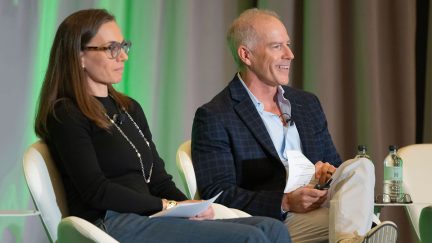For more stories like this, sign up for the PLANADVISERdash daily newsletter.
PANC 2015: “Industry Insights”
Pensionmark Financial Group and CAPTRUST Financial Advisers formed a strategic partnership in March. At the 2015 PLANADVISER National Conference in Orlando, Florida, Pensionmark CEO Troy Hammond and CAPTRUST CEO Fielding Miller talked about what prompted the deal and how it is benefiting advisers.
Pensionmark has an adviser support program to help advisers respond to inflection points, Hammond said. Much like other advisers, Pensionmark hit an inflection point last year and wanted to expand. “We spent a lot of time last year evaluating how to take Pensionmark to the next level, to evolve. CAPTRUST and Pensionsmark have been very friendly competitors. We share clients as well as best practices,” he said. He then just picked up the phone to speak with CAPTRUST and started talking about the potential of working together.
For its part, CAPTRUST “had a strategic interest in an
affiliate because we expect the bull market for retirement plan advisers to
continue for some time,” Miller said. “A lot of advisers will need a strong
retirement back office, so we decided to partner with Pensionmark, allowing
them to take a 49% stake. We have both an affiliate and a partnership model.”
NEXT: The various roles Pensionmark and
CAPTRUST play
CAPTRUST is the broker/dealer, and Pensionmark supplies the
back-office support and registered investment adviser (RIA) intellectual
capital, Hammond said. “I’ve been in this business for 25 years and have had
four partners. This is the first time I’ve had a partner with whom Pensionmark
is philosophically and morally aligned. CAPTRUST has some great resources, which
has allowed us to roll out the Smart Lifecycle custom target-date fund since forming
the partnership.”
Miller added: “Troy and his team run the business. We are a strategic partner
that brings capital and business acumen.”
As to whether the advisers the two entities serve are different or the same,
Hammond and Fielding said that in both cases, they are retirement specialists
looking to grow their business. Asked whether the advisers can be affiliates or
acquired, Miller said it depends on the adviser preference. However, given the
strong CAPTRUST and Pensionmark brands, “advisers to independent firms can
benefit from affiliating under one brand,” he said.
As to the trends advisers will face in the coming years, Miller said that requests for proposals (RFPs) for advisers have become standard. “That will rationalize the industry,” as it will make it clear to plan sponsors which advisers only dabble in retirement plans, he said. Fee transparency will also bring increased competition from other advisers. “Our fees are out there for public consumption, so there is a lot of pressure for us to bring more value to the table.”
Thirdly, as investment menus increasingly use passive investment and target-date funds (TDFs), it will be a challenge for advisers to prove their value, he said. Fourth, he foresees more demand for advice and wellness programs. If advisers aren’t already offering this, they will be at a disadvantage, he said. Lastly, regulatory pressures are rapidly increasing. “The price of poker is going up. It will be much more expensive” to do business, Miller said.
In addition, advisers must think about succession planning, Hammond said. “Otherwise, your practice will dissipate,” he said. By partnering with CAPTRUST, Pensionmark solved this problem for itself, he said.
You Might Also Like:

Rethinking Opportunities for RIA Growth

Advisers Step Up as Clients Face Market Uncertainty
